
- •Stahara publishing company
- •Lesson 1.
- •Instead of trying to free your wrists by the strength of your arms, you force them out by the strength of the abdomen and the weight of the body.
- •Instead of memorizing this as an abstract principle, visualize it in the concrete instance of the simple trick exemplified on the preceding page.
- •Ichi II-gatashi.
- •Lesson 2.
- •In fact, in a five minutes bout in jujitsu each will have made the other quit several times and they will always keep smiling.
- •Lesson 3.
- •Lesson 4.
- •Lesson 5.
- •Lesson 7.
- •In short, they wanted to train, not only the muscular endurance of the soldier, but his morale, or fighting spirit.
- •Lesson 8.
- •Lesson 9.
- •Lesson 10.
- •Lesson 11.
- •In practice put strength into the blow but stop it a few inches from his neck. With this blow it is an easy matter to knock a man out.
- •Lesson 12.
- •Lesson 13.
- •Summary
- •Lesson 14.
- •Seized from behind -- Fig. 82
- •Lesson 15.
- •Lesson 16.
- •In practice exert only sufficient pressure to force opponent to give the signal of defeat.
- •Lesson 19.
- •Lesson 20.
- •Lesson 21.
- •Lesson 22.
- •Lesson 23.
- •Lesson 24.
- •In teaching men who were going to the war, all the training was directed towards making them kick or hit a vital spot rather than try for a hold.
- •It seems that the burglar threatened him by brandishing a two-handed, razor-edged Japanese sword over his head, and demanded his money.
- •Lesson 25.
- •Lesson 26.
- •Lesson 27.
- •Lesson 28.
- •Lesson 29.
- •Lesson 30.
- •Lesson 31.
- •In practice, do this so slowly that there is no danger of injuring your opponent's elbow. He will stand still and let you experiment, and you must allow him the same privilege.
- •Lesson 32.
- •Lesson 33.
- •Lesson 34.
- •Lesson 35.
- •Lesson 36.
- •In practice do it slowly and release him the instant he quits.
- •Lesson 37.
- •Lesson 38.
- •Lesson 39.
- •Verbum sap: a word to the wise is sufficient
- •Lesson 42.
- •Lesson 43.
- •Lesson 44.
- •Lesson 47.
- •Lesson 48.
- •It is not recommended as a practical fighting trick, as it leaves you open to a kick just before it is secured.
- •Lesson 51.
- •Lesson 52.
- •Lesson 53.
- •If you start too roughly at first with one another, you will never continue your practice to the point of proficiency. Advanced practice in throwing man from behind
- •Lesson 54.
- •Lesson 55.
- •Lesson 56.
- •If the escape be executed before Assailant gets his full pressure on your neck, it is easy to get away.
- •Lesson 57.
- •If you do it gently, not only is there no danger, but no discomfort.
- •Lesson 58.
- •Lesson 59.
- •If you are on patrol duty and see an enemy ahead of you whom you must "get" without letting him give the alarm, steal up silently and get him unawares.
- •Lesson 60.
- •Lesson 62.
- •In practice, be gentle. In actual attack knock him out, or at least render him speechless, by a sharp blow on the windpipe with the wrist.
- •The scope of this course
- •"It isn’t whether we win or lose, but how we play the game."
In short, they wanted to train, not only the muscular endurance of the soldier, but his morale, or fighting spirit.
Shakespeare said:
He that hath no stomach for the fight
Let him depart.
The bayonet instructors wanted to train our "Stomach for the fight."
The word "guts" then, scientifically analyzed, combines both the idea of putting the strength and weight of your body into any given blow and the idea of putting all your mind and will and soul into any given movement.
The same idea inspired Shakespeare when he wrote the above quotation in classical English, and the bayonet men when they punctuated their instructions with a phrase which many will term vulgar, and which at best is slang.
What Shakespeare and the bayonet instructors dimly visualized this course teaches as a specific principle. The knack of putting your "guts" into it can be learnt, separate and distinct from anything else, and once acquired can be applied to anything.
The Stahara consists of the diaphragm (the large muscle which divides the cavity of the heart and lungs from the cavity of the stomach and intestines) on the top, and the muscular floor of the abdominal region, and all that lies between.
When the body is used properly as by an expert in any branch of sport, the weight of the whole body, the weight of the Stahara, goes into any stroke he may make, as in golf or tennis, thereby distinguishing him from the beginner, who depends largely on the working of his arms and legs.
After a course in Stahara training, with the increased faculty of using the body as a whole, and the automatic realization of the fact that the center of gravity lies in the center of the Stahara, a sportsman will be able to watch an expert play golf, for instance, and will appreciate just how the expert uses his Stahara.
He will then be better able to analyze his own movements and correct them accordingly.
Stahara supplies not only a word that can be used, but also a scientific and complete training for what, up till now, was only a dimly realized, vague idea, not yet developed into a principle.
Stahara simply means "Guts" -- moral and physical.
Lesson 8.
This lesson teaches you --
How to clasp hands when taking hold. An interesting variation of the waisthold. The chin shove. Correct leverage in the chin shove. Advanced practice in the chin shove.
In clasping hands behind opponent's back always take the grip shown in fig. 23.
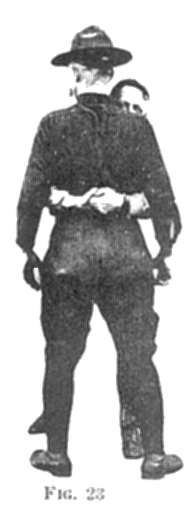
Unless he is a much smaller man, in which case clasp your left wrist with your right hand.
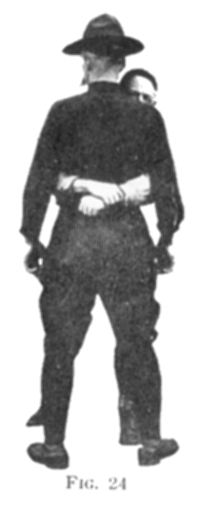
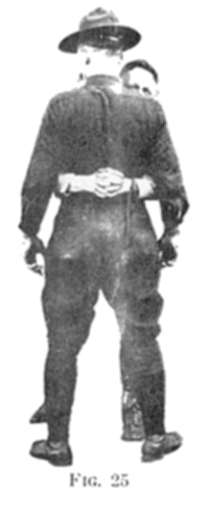
Never use the grip shown in fig. 25.
If your opponent falls on your fingers when they are clasped this way they may be broken.
Again, if he lies beneath you his weight may jam your fingers so that you would have difficulty in freeing your arms while his arms would be free to attack.
These instructions as to correct methods of clasping hands are chiefly for the man who acts in the role of Assailant in this waisthold series, and in the "Seized from Behind Series" in Book 4.
AN INTERESTING VARIATION OF THE WAISTHOLD
There is a peculiarly sensitive spot about two inches long up and down each side of the backbone halfway between the waistline and shoulders.
Press the big third knuckle joint of your first finger into your first finger into your own back till you discover the spot.
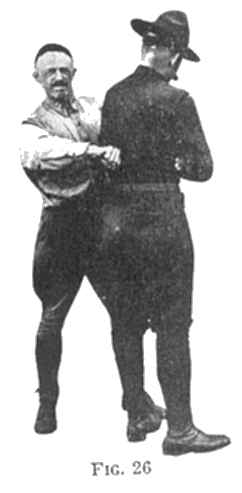
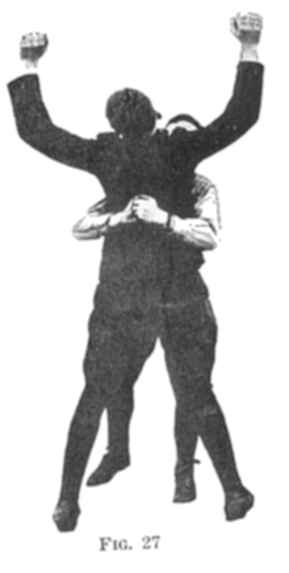
Apply pressure here with the knuckle simultaneously with the pressure of your chin on his chest and the pain will cause him to quit.
As soon as he quits, let go and allow him to practice on you.
Some men are not sensitive to pressure here, but many people are so susceptible to pain at this spot that the trick will cause them to quit, and may even knock them out. Therefore when applying it to anyone, go slowly at first.
Experiment on each other a few times that you may acquire a moderation and temperance and so avoid injuring a less robust companion. NOTES ON THE WAISTHOLD
Before practicing the chin shove given on the following page you and your partner should execute the waisthold as taught in Book 1, three times each.
The waisthold is not much use against a heavier man and is not taught in this course for its fighting value.
It is taught in order to provide an Assailant for the man who wants to learn the chin shove. It is the first link in the chain of dovetailed tricks.
It is taught because by means of it you learn the correct method of practice before proceeding to the more advanced tricks which might be dangerous unless practiced properly.
It takes away the beginner's nervousness before he comes to the more advanced tricks.
CHIN SHOVE
"ONE"
Assailant steps forward with left foot as if trying to secure the waisthold.
Step forward and slip your left hand inside Assailant's right arm and place it halfway around his waist.
Place the palm of your right hand under Assailant's chin, forearm straight up and down and close to his chin.
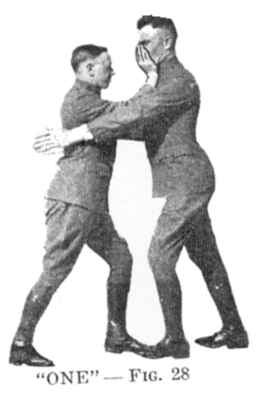
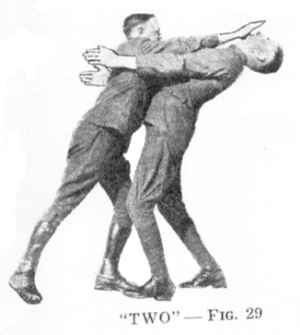
"TWO"
Pull his waist forward with your left hand. Shove his head backward with your right until he is in position of fig. 29.
Be careful not to let him fall. Keep your balance in the Stahara.
This movement is not done by sheer strength, but by destroying Assailant's balance through the proper coordination of your right and left hands.
Be careful not to jerk his head back. In a real fight you would do so, but if you hurt your partner it will simply curtail your practice. WRONG WAY TO TRY CHIN SHOVE
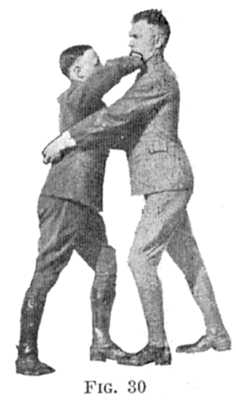
If you hold your elbow away out as shown in fig. 30 you are using only your arm and shoulder muscles against the strength of his neck.
This is using your strength to the least advantage, as an ordinary man's neck is stronger than his arm and shoulder.
Take the right position of fig. 28, and put the strength of your Stahara -- the strength of your whole body -- into the trick.
Experiment and learn the correct method of shoving.
In a real fight you will not stop at the position shown in fig. 29, but will throw opponent over backward.
If performed with sufficient quickness he will be knocked out by the concussion of his head on the ground.
Further, there would be no pause between "ONE" and "TWO" which is simply the analytical method of learning this trick.
It is unnecessary to throw the opponent in practice. CORRECT LEVERAGE IN CHIN SHOVE
Take position of fig. 31. Assailant is holding you around waist. You have your hand on his chin.
Let him stiffen his neck and resist your efforts to push him back, so that you are struggling with him strength against strength. You will be unable to push him back.
Instead of continuing to push back against his strength push up, dropping your body a little so that your Stahara is behind the upward effort.
This will instantly get him off balance and you can easily subdue him.
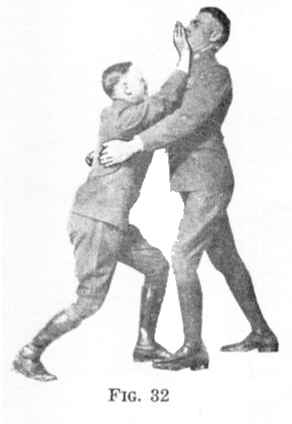
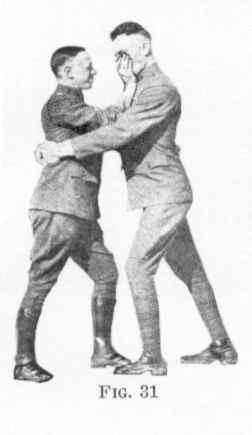
ADVANCED PRACTICE IN THE CHIN SHOVE
Compare your position with each illustration until you have learnt the applied mechanics of the trick and can get a stronger man off his balance and so discount his strength by scientific shoving.
This method enables you to commence your study of this course with the same safety and accuracy of movement as if you were being carefully grounded in first principles by a painstaking teacher.
In the early stages of practice it is necessary to pause between the counts "ONE" and "TWO". Otherwise you may inadvertently give your Assailant too severe a tap on the chin. When first shoving Assailant's head back, do it very slowly.
For advanced practice, discard the counts and both attack at the word, "GO", Assailant with the waisthold, opponent with the chin shove.
Assailant will attack slowly at first, but as opponent becomes more expert with the chin shove will attack with increasing swiftness.
There must be no finessing with the arms. Assailant, who attacks with waisthold, knows that opponent's arms are coming inside his, but must not try to parry them. He must maintain the original direction of attack. His one endeavor must be to get opponent firmly around the waist before opponent can get the chin shove.
In a real fight it would not be necessary to place left hand behind Assailant's back, a blow with the heel of the hand on his jaw is the best method.
This practice will enable you to develop the power to hit a hard blow when necessary, and will also train your eye and presence of mind so that in an emergency you would act vigorously. THE BEST DEFENSE IS ATTACK
The best defense is attack. In other words, keep your opponent so busy defending himself that he has no time to attack you.
"Beware of entrance to a quarrel, but being in
"Bear it that the opposer may beware of thee."
In actual combat, do not wait until he attacks you, but get the jump on him.
But the best way to learn a trick is to practice it on a man who is attacking you.
If you practice it on an unresisting opponent, his body is relaxed and you do not meet with the proper resistance.
On the other hand, if you tell him to resist you every time, he will soon be able to prevent you getting the grip and that makes it impossible for you to practice.
Get your opponent to attack you as instructed. This not only provides you with the proper resistance, but reproduces as nearly as possible the conditions under which you would actually have to use the tricks.
Furthermore, it trains your reflex action and makes you instinctively do the right trick.
This feature of the course makes it unique for by this method you will be able to do the tricks better in two or three weeks than you would under years of the old system.
